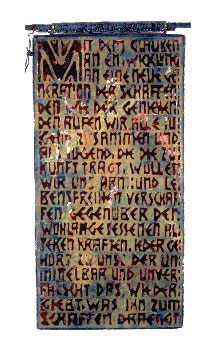
Brücke Manifesto, encaustic on wood, 1999, 21" x 11"
Replication of Ernst Ludwig Kirchner’s woodcut from the new zine
of Die Brücke artists’ group, Germany, around 1908. Woodcut
became “waxcut”, incised, dug out and filled, scraped back,
and superimposed on a colour sketch that suggests any of Kirchner’s
Berlin demi-monde paintings of around 1913.
I consider myself a medium-oriented artist, fascinated by the beauty and the technical possibilities of encaustic paint. The replication of artifacts - rock posters, road signs, Egyptian papyri, Sumerian inlay, Medieval enamels and illuminations, German expressionist woodcuts, black figured pottery, Assyrian bas relief, Beardsley’s pen illustrations, and, most recently, archival drawings of architectural elevations and newspaper clippings - has been my vehicle for the discovery of wax paint’s many talents. The process, and not just the final appearance, imitates. Cutting out a hole in the bed of yellow wax, and filling it with garnet-coloured hot wax, is very like enamelling or setting in jewels. A second rendering of a woodcut, Kandinsky’s “Riders in the Ravine” I did with an intricate stencil, so that, where the replicating of Brücke Manifesto was like cutting and inking the plate, Kandinsky in the Ravine (encaustic on wood, 1999. 15" x 20") imitated the pulling of the print.